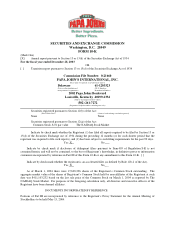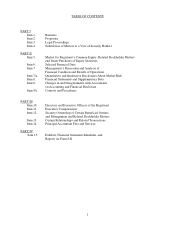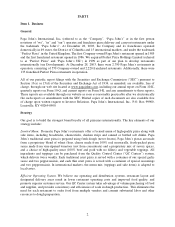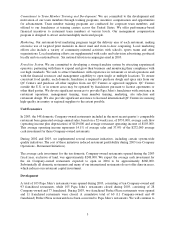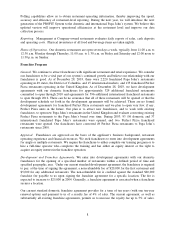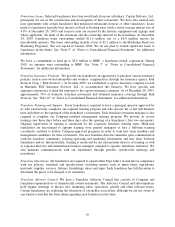Papa Johns 2003 Annual Report Download - page 3
Download and view the complete annual report
Please find page 3 of the 2003 Papa Johns annual report below. You can navigate through the pages in the report by either clicking on the pages listed below, or by using the keyword search tool below to find specific information within the annual report.
2
PART I
Item 1. Business
General
Papa John’s International, Inc. (referred to as the “Company”, “Papa John’s” or in the first person
notations of “we”, “us” and “our”) operates and franchises pizza delivery and carryout restaurants under
the trademark “Papa John’s”. At December 28, 2003, the Company and its franchisees operated
domestically in 49 states, the District of Columbia and 15 international markets, and under the trademark
“Perfect Pizza” in the United Kingdom. The first Company-owned Papa John’s restaurant opened in 1985
and the first franchised restaurant opened in 1986. We acquired Perfect Pizza Holdings Limited (referred
to as “Perfect Pizza” and “Papa John’s UK”) in 1999 as part of our plan to develop restaurants
internationally (see Development). At December 28, 2003, there were 2,790 Papa John’s restaurants in
operation, consisting of 570 Company-owned and 2,220 franchised restaurants. Additionally, there were
135 franchised Perfect Pizza restaurants in operation.
All of our periodic report filings with the Securities and Exchange Commission (“SEC”) pursuant to
Section 13(a) or 15(d) of the Securities and Exchange Act of 1934, as amended, are available, free of
charge, through our web site located at www.papajohns.com, including our annual report on Form 10-K,
quarterly reports on Form 10-Q, and current reports on Form 8-K, and any amendments to those reports.
These reports are available through our website as soon as reasonably practicable after we electronically
file such reports or amendments with the SEC. Printed copies of such documents are also available free
of charge upon written request to Investor Relations, Papa John’s International, Inc., P.O. Box 99900,
Louisville, KY 40269-0900.
Strategy
Our goal is to build the strongest brand loyalty of all pizzerias internationally. The key elements of our
strategy include:
Limited Menu. Domestic Papa John’s restaurants offer a focused menu of high-quality pizza along with
side items, including breadsticks, cheesesticks, chicken strips and canned or bottled soft drinks. Papa
John’s traditional crust pizza is prepared using fresh dough (never frozen). Papa John’s pizzas are made
from a proprietary blend of wheat flour, cheese made from 100% real mozzarella, fresh-packed pizza
sauce made from vine-ripened tomatoes (not from concentrate) and a proprietary mix of savory spices,
and a choice of high-quality meat (100% beef and pork with no fillers) and vegetable toppings. All
ingredients and toppings can be purchased from the Quality Control Center (“QC Centers”) system,
which delivers twice weekly. Each traditional crust pizza is served with a container of our special garlic
sauce and two pepperoncinis, and each thin crust pizza is served with a container of special seasonings
and two pepperoncinis. In international markets, the menu mix (toppings and side items) is adapted to
local tastes.
Efficient Operating System. We believe our operating and distribution systems, restaurant layout and
designated delivery areas result in lower restaurant operating costs and improved food quality, and
promote superior customer service. Our QC Center system takes advantage of volume purchasing of food
and supplies, and provides consistency and efficiencies of scale in dough production. This eliminates the
need for each restaurant to order food from multiple vendors and commit substantial labor and other
resources to dough preparation.

